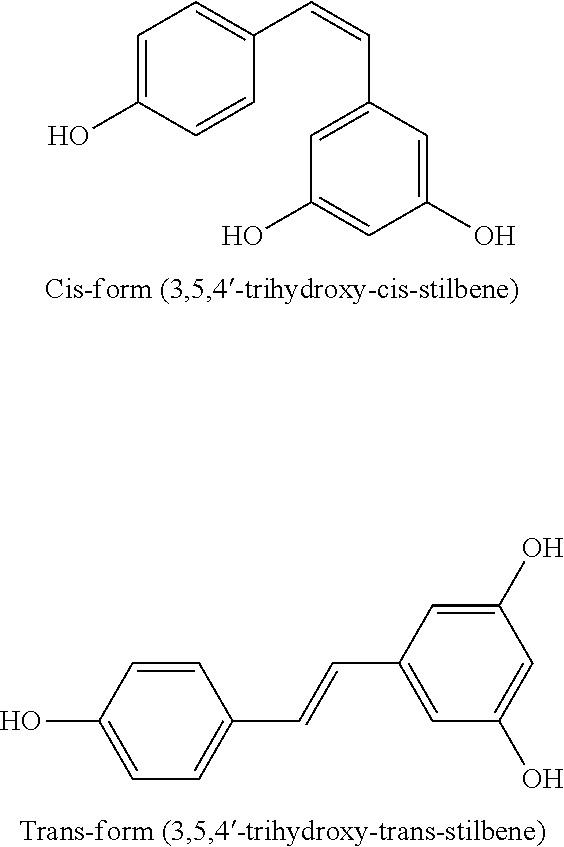Beverage container coated with a resveratrol layer
a beverage container and resveratrol technology, applied in the field of beverage containers, can solve the problems of weight, durability, and less than optimal recycling ability of glass packaging, and achieve the effect of successfully using wine packaging media for storag
- Summary
- Abstract
- Description
- Claims
- Application Information
AI Technical Summary
Benefits of technology
Problems solved by technology
Method used
Image
Examples
example 1
Preparation of Lacquers (Coating Layers) Containing Resveratrol
Bisphenol A-Free Polyester Acrylate Containing Layer (Prepared According to Example 2 of WO 2008036629 A2)
[0127]A 2-liter flask was equipped with a stirrer, packed column, condenser, thermocouple, heating mantle and nitrogen blanket. The following were added to the flask: 498.6 grams of propylene glycol, 80.1 grams of trimethylolpropane, 880.1 grams of terephthalic acid, 40.0 grams of isophthalic acid, and 2.0 grams of FASCAT 9100 butylhydroxyoxostannane catalyst (available from Total Petrochemicals USA, Inc., Houston, USA).
[0128]The flask contents were slowly heated to 225° C. to 235° C. under a nitrogen blanket, and the water from the resulting polycondensation reaction was distilled off. Once the reaction mixture became clear and the temperature at the head of the column dropped, the reaction mixture was cooled to 160° C., and 85.5 grams of isophthalic acid and 16.0 grams of maleic anhydride were added to the flask. T...
example 2
Application of Resveratrol-Containing Coating Layer to Packaging Material / Container Wall (Before / After Forming of the Container)
[0140]The lacquers as described in Example 1 are applied to the aluminium can as a coating layer by using a twin gun to coat the internal wall and dome of the can. The amount of lacquer to be applied depends on the size of the can to be coated. In this Example, cans with a volume of 150 to 440 ml have been coated using 100 to 240 mg of Lining A or Lining B containing 0.01 wt % resveratrol.
[0141]The uncured coating layer is cured for 80 to 230 seconds at a bake temperature between 180 and 250° C. The resulting distribution thickness of the layer lies between 3.5 and 8.4 grams per square meter (gsm). The thickness of the film layer is indicated for the top, middle, bottom and dome section of a can coated with Lining A containing 0.01 wt % resveratrol in Table 1.
TABLE 1Can size -Film weight -Film distribution - gsmmlmgTopMiddleBottomDome1501006.06.96.96.520012...
example 3
Assessment of Physical Parameters of Coated Cans
[0142]The cans obtained in Example 2 were examined for adhesion of the coating layer (AS 1580 Method 408.4), impact resistance at 18 Joule (AS 1580 Method 406.1), pinholing after incubation in HCl for 5 minutes (SSL test method). They were further examined microscopically for blistering (AS 1580 Method 481.1.9), delamination (AS 1580 Method 481.1.10) and corrosion (AS 1580 Method 481.3). The performance of the can in all tests was excellent and the integrity of the coating layer was maintained. Results of these tests are shown in Table 2.
TABLE 2TestTest MethodResultAdhesionAS 1580 Method 408.40, 0, 0Cross CutRating 0 = no removal of coatingAv = 05 = complete removal of coatingImpact ResistanceAS 1580 Method 406.1No failure of coating atReverse Impact18 Joule (1.8 kgf m)PinholingSSL Test Method0 pinholes / canCan filled with HCl and allowed to standfor 5 minutes. Points of hydrogenevolution observed.Microscopic examinationBlisteringAS 158...
PUM
| Property | Measurement | Unit |
|---|---|---|
| product time test | aaaaa | aaaaa |
| time | aaaaa | aaaaa |
| time | aaaaa | aaaaa |
Abstract
Description
Claims
Application Information
 Login to View More
Login to View More - R&D
- Intellectual Property
- Life Sciences
- Materials
- Tech Scout
- Unparalleled Data Quality
- Higher Quality Content
- 60% Fewer Hallucinations
Browse by: Latest US Patents, China's latest patents, Technical Efficacy Thesaurus, Application Domain, Technology Topic, Popular Technical Reports.
© 2025 PatSnap. All rights reserved.Legal|Privacy policy|Modern Slavery Act Transparency Statement|Sitemap|About US| Contact US: help@patsnap.com

